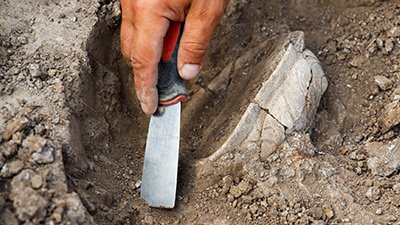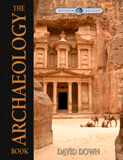Tablet Holds Eye Witness Account of Asteroid Impact
An ancient clay tablet may describe an eyewitness account of an asteroid impact—an impact said to have inspired the biblical account of the destruction of Sodom and Gomorrah.
News Source
- The (London) Times: “Clay Tablet Identified as Asteroid that Destroyed Sodom and Gomorrah”
The clay tablet, found at Nineveh a century and a half ago, features cuneiform symbols that were finally deciphered by researchers at Bristol University. About half of the symbols on the tablet have not survived, however.
About half of the symbols on the tablet have not survived.
The symbols are thought to be a copy made in 700 BC of the notes of a Sumerian astronomer who was watching the night sky thousands of years earlier. That astronomer referred to something in the sky as a “white stone bowl approaching” that “vigorously swept along.” Based on this crude description, the team concluded the asteroid likely crashed in the Austrian Alps with a “cataclysmic impact” equivalent to more than 1,100 tons (1,000 tonnes) of TNT.
The Bristol team ran the star descriptions on the tablet through a computer recreation of the night sky and learned the stars represent a view before dawn on June 29 of 3123 BC. (Details on this aspect of the research were not listed in the Times story.)
The researchers allege that there are “at least 20 ancient myths” (the Times’s wording) that record devastation “of the type and on the scale” of the asteroid’s impact—including, they say, the account in Genesis of the destruction of Sodom and Gomorrah.
Let’s take a look at Genesis 19:23–29:
The sun had risen upon the earth when Lot entered Zoar. Then the LORD rained brimstone and fire on Sodom and Gomorrah, from the LORD out of the heavens. So He overthrew those cities, all the plain, all the inhabitants of the cities, and what grew on the ground. But his wife looked back behind him, and she became a pillar of salt. And Abraham went early in the morning to the place where he had stood before the LORD. Then he looked toward Sodom and Gomorrah, and toward all the land of the plain; and he saw, and behold, the smoke of the land which went up like the smoke of a furnace. And it came to pass, when God destroyed the cities of the plain, that God remembered Abraham, and sent Lot out of the midst of the overthrow, when He overthrew the cities in which Lot had dwelt.
Before we go too far analyzing this news, let’s remember that half of the writing on this tablet did not survive. It is also questionable whether the researchers were able to pull such exact information on the asteroid from the tablet; instead, it seems they may be trying to link up the asteroid with a known landslide whose geological results have been detected near Köfels, Austria (though that landslide has been dated by others to 7800 BC; it certainly sounds like a stretch either way).
But according to Ussher’s chronology, Abraham lived in the early second millennium BC, from 1996 BC to about sometime in the 1800s BC. According to the Bible’s account of Abraham, the incidents at Sodom and Gomorrah happened before the birth of Isaac but after Abraham left Ur, and thus the destruction of those cities occurred in the latter half of the twentieth century BC (the late 1900s). Furthermore, 3123 would have been well before the Flood of Noah’s Day, so unless the original account this tablet was copied from was carried on board the Ark, it would not have survived to be copied in 700 BC.
This tablet could not be as old as the team says it is.
In other words, this tablet could not be as old as the team says it is, nor could an asteroid in 3123 BC have had anything to do with Sodom and Gomorrah. It is possible—as in, the Bible’s text does not preclude it—that God used such natural objects as meteors or an asteroid in the process of destroying Sodom and Gomorrah, so long as sulfur was involved in the conflagration. (In the same way, the Flood was a “natural” catastrophe—involving real water, real rain, real geological and likely volcanic activity—that was triggered by supernatural forces.) Yet finding how natural forces were involved in the destruction of Sodom and Gomorrah would not replace the supernatural element in the account, since God’s Word plainly describes the event as more than a by-chance natural disaster.
It isn’t wrong to hypothesize that God used nature in executing His will, so long as we do not restrict Him to only using nature (i.e., saying that all miracles have a natural explanation), particularly if it requires twisting the Scriptures to do so. In fact, crucial to understanding that the Bible is real history is remembering that God interacts in the real world, and not just on an invisible, “supernatural” level.
For More Information: Get Answers
Remember, if you see a news story that might merit some attention, let us know about it! (Note: if the story originates from the Associated Press, FOX News, MSNBC, the New York Times, or another major national media outlet, we will most likely have already heard about it.) And thanks to all of our readers who have submitted great news tips to us. If you didn’t catch all the latest News to Know, why not take a look to see what you’ve missed?
(Please note that links will take you directly to the source. Answers in Genesis is not responsible for content on the websites to which we refer. For more information, please see our Privacy Policy.)
Recommended Resources

Answers in Genesis is an apologetics ministry, dedicated to helping Christians defend their faith and proclaim the good news of Jesus Christ.
- Customer Service 800.778.3390
- Available Monday–Friday | 9 AM–5 PM ET
- © 2025 Answers in Genesis





